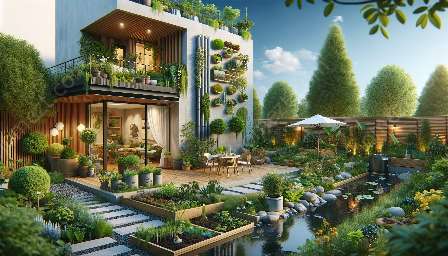When it comes to creating an eco-friendly and sustainable outdoor space, natural building techniques offer a wealth of possibilities. By integrating permaculture principles with innovative building methods, you can transform your yard and patio into a harmonious and regenerative environment. In this article, we will explore various natural building techniques that align with permaculture and can be applied to enhance the beauty and functionality of your outdoor space.
Understanding Permaculture and Natural Building
Before delving into the specifics of natural building techniques, it's important to understand the foundational principles of permaculture and how they tie into sustainable construction practices. Permaculture is a holistic design approach that aims to create regenerative and self-sustaining systems inspired by natural ecosystems. It emphasizes the importance of working with nature, rather than against it, and seeks to create integrated and interconnected landscapes that provide for human needs while also benefiting the environment.
Natural building, as a practice, aligns closely with permaculture by prioritizing the use of locally available, sustainable, and non-toxic materials. It emphasizes energy efficiency, waste reduction, and the integration of natural elements into the built environment. By combining permaculture principles with natural building techniques, you can create structures that are not only aesthetically pleasing but also environmentally responsible and resilient.
Cob Construction: An Earth-Friendly Approach
One of the most traditional natural building techniques is cob construction, which involves mixing clay-rich soil with fibrous material, such as straw, to create a versatile building material. Cob can be used to construct walls, benches, and ovens, and its plasticity allows for the creation of organic, curvilinear forms that blend seamlessly with the natural environment.
By using cob for your yard and patio projects, you can benefit from its excellent thermal mass properties, which help regulate indoor temperatures, reducing the need for artificial heating and cooling. In addition, cob structures are durable, low-cost, and can be built using minimal tools and equipment, making them accessible to DIY enthusiasts and professional builders alike.
Bamboo and Timber: Sustainable Structural Elements
When it comes to building pergolas, trellises, and other structural elements for your yard and patio, bamboo and sustainably harvested timber are excellent choices. Bamboo, in particular, is a rapidly renewable material with exceptional strength-to-weight ratios, making it ideal for creating lightweight yet resilient structures.
Whether you are constructing a shaded seating area or a support system for climbing plants, bamboo and timber can be used to create elegant, natural structures that complement your outdoor space. By selecting materials that have been harvested responsibly and using designs that integrate seamlessly with the surrounding landscape, you can achieve a harmonious balance between human habitation and the natural world.
Living Roofs and Walls: Blurring the Boundaries
Incorporating living roofs and walls into your yard and patio design not only adds beauty and biodiversity but also contributes to energy efficiency and stormwater management. A living roof, covered in vegetation, provides natural insulation, reduces urban heat island effects, and mitigates rainwater runoff. Similarly, living walls, adorned with climbing plants or modular planter systems, enhance air quality, create microclimates, and act as natural sound barriers.
By utilizing these natural building techniques, you can transform static, conventional surfaces into living, breathing habitats that support a variety of flora and fauna. The integration of living roofs and walls aligns perfectly with permaculture ideals and showcases the potential of sustainable design to enhance both the ecological and aesthetic value of your outdoor space.
Conclusion
Embracing natural building techniques in your yard and patio projects not only allows you to create functional and beautiful structures but also contributes to the creation of regenerative and sustainable environments. By aligning these techniques with permaculture principles, you can cultivate a harmonious relationship between human dwellings and the natural world, fostering resilience, biodiversity, and beauty. Whether you choose to work with cob, bamboo, or living plant systems, integrating natural building techniques into your outdoor space empowers you to become a steward of the land, promoting ecological health and creating meaningful connections with the living landscape.


